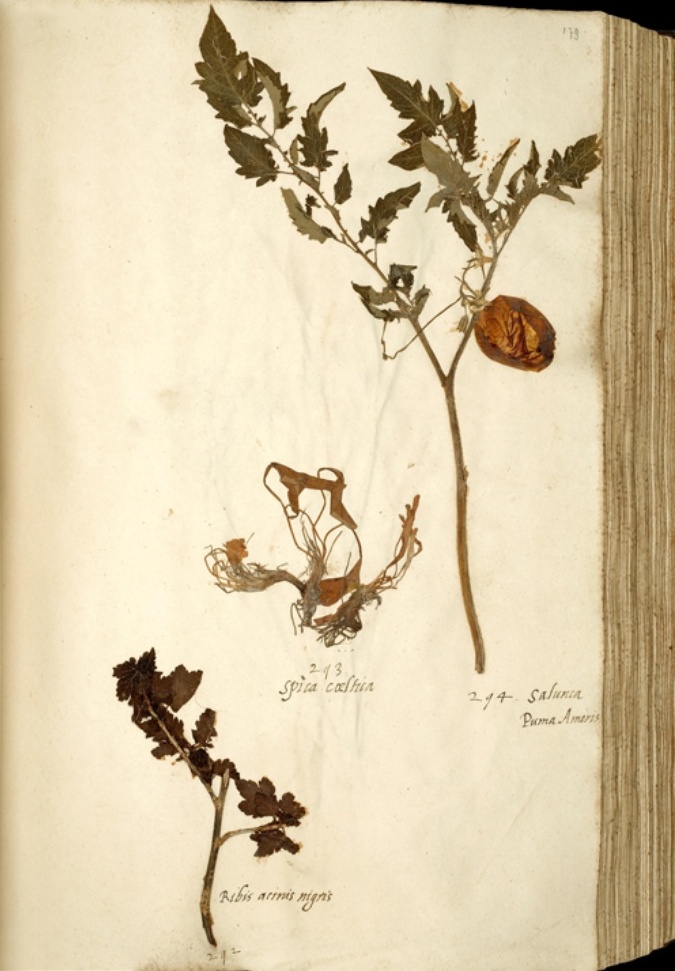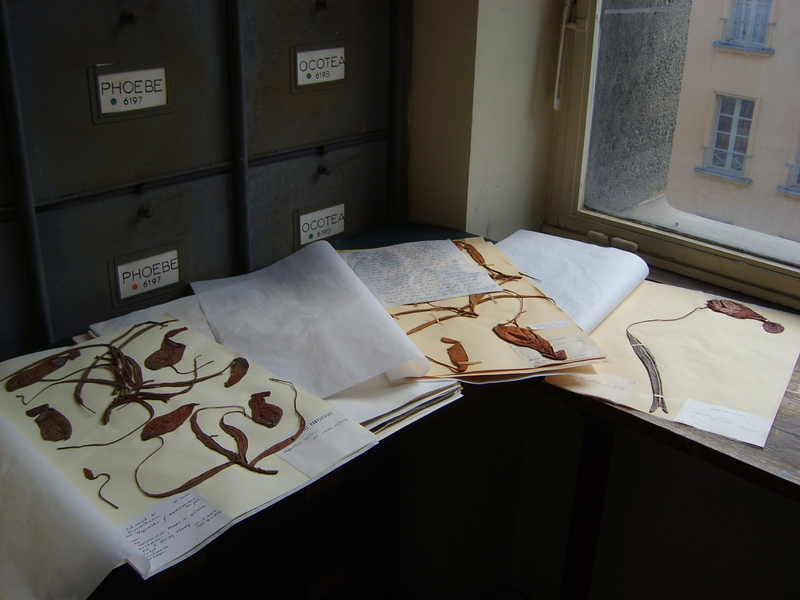|
Plant Collecting
Plant collecting is the acquisition of plant specimens for the purposes of research, cultivation, or as a hobby. Plant specimens may be kept alive, but are more commonly dried and pressed to preserve the quality of the specimen. Plant collecting is an ancient practice with records of a Chinese botanist collecting roses over 5000 years ago. Herbaria are collections of preserved plants samples and their associated data for scientific purposes. The largest herbarium in the world exist at the Muséum National d'Histoire Naturelle, in Paris, France. Plant samples in herbaria typically include a reference sheet with information about the plant and details of collection. This detailed and organized system of filing provides horticulturist and other researchers alike with a way to find information about a certain plant, and a way to add new information to an existing plant sample file. The collection of live plant specimens from the wild, sometimes referred to as plant hunting, is an ... [...More Info...] [...Related Items...] OR: [Wikipedia] [Google] [Baidu] |
Blotting Paper
Blotting paper is a highly absorbent type of paper used to absorb ink or oil from writing material, particularly when quills or fountain pens were popular. It could also be used in testing how much oil is present in products. Blotting paper referred to as bibulous paper is mainly used in microscopy to remove excess liquids from the slide before viewing. Blotting paper has also been sold as a cosmetic to aid in the removal of skin oils and makeup. Manufacture Blotting paper is made from different materials of varying thickness, softness, etc. depending on the application. It is often made of cotton and manufactured on special paper machines. Blotting paper is reputed to be first referred to in the English language in the 15th century but there is a tradition in Norfolk, England that it was invented by accident at Lyng Mill on the River Wensum. It is reported that a Berkshire (England) paper mill worker failed to add sizing to a batch of paper that was being produced. The b ... [...More Info...] [...Related Items...] OR: [Wikipedia] [Google] [Baidu] |
Collectible
A collectable (collectible or collector's item) is any object regarded as being of value or interest to a collector. Collectable items are not necessarily monetarily valuable or uncommon. There are numerous types of collectables and terms to denote those types. An antique is a collectable that is old. A curio is something deemed unique, uncommon, or weird, such as a decorative item. A manufactured collectable is an item made specifically for people to collect.Danziger, Pamela (July 1, 1069)''Why People Buy Things They Don't Need: Understanding and Predicting Consumer Behavior'' Kaplan Publishing. The business of collectables Created to be collected A manufactured collectable (often referred to as a contemporary collectable) is an item made specifically for people to collect. Examples of items commonly sold as collectables include plates, figurines, bells, graphics, steins, dolls, and art. Some companies that produce manufactured collectables are members of The Gi ... [...More Info...] [...Related Items...] OR: [Wikipedia] [Google] [Baidu] |
Conservation Ethic
Nature conservation is the ethic/moral philosophy and conservation movement focused on protecting species from extinction, maintaining and restoring habitats, enhancing ecosystem services, and protecting biological diversity. A range of values underlie conservation, which can be guided by biocentrism, anthropocentrism, ecocentrism, and sentientism, environmental ideologies that inform ecocultural practices and identities. There has recently been a movement towards evidence-based conservation which calls for greater use of scientific evidence to improve the effectiveness of conservation efforts. As of 2018 15% of land and 7.3% of the oceans were protected. Many environmentalists set a target of protecting 30% of land and marine territory by 2030. In 2021, 16.64% of land and 7.9% of the oceans were protected. The 2022 IPCC report on climate impacts and adaptation, underlines the need to conserve 30% to 50% of the Earth's land, freshwater and ocean areas – echoing the 30% g ... [...More Info...] [...Related Items...] OR: [Wikipedia] [Google] [Baidu] |
Collecting
The hobby of collecting includes seeking, locating, acquiring, organizing, cataloging, displaying, storing, and maintaining items that are of interest to an individual ''collector''. Collections differ in a wide variety of respects, most obviously in the nature and scope of the objects contained, but also in purpose, presentation, and so forth. The range of possible subjects for a collection is practically unlimited, and collectors have realised a vast number of these possibilities in practice, although some are much more popular than others. In collections of manufactured items, the objects may be antique or simply collectable. Antiques are collectable items at least 100 years old, while other collectables are arbitrarily recent. The word ''vintage'' describes relatively old collectables that are not yet antiques. Collecting is a childhood hobby for some people, but for others, it is a lifelong pursuit or something started in adulthood. Collectors who begin early in life oft ... [...More Info...] [...Related Items...] OR: [Wikipedia] [Google] [Baidu] |
Dichotomous Keys
In phylogenetics, a single-access key (also called dichotomous key, sequential key, analytical key, or pathway key) is an identification key where the sequence and structure of identification steps is fixed by the author of the key. At each point in the decision process, multiple alternatives are offered, each leading to a result or a further choice. The alternatives are commonly called "leads", and the set of leads at a given point a "couplet". Single access keys are closely related to decision trees and binary search trees. However, to improve the usability and reliability of keys, many single-access keys incorporate reticulation, changing the tree structure into a directed acyclic graph. Single-access keys have been in use for several hundred years. They may be printed in various styles (e. g., linked, nested, indented, graphically branching) or used as interactive, computer-aided keys. In the latter case, either a longer part of the key may be displayed (optionally hyperl ... [...More Info...] [...Related Items...] OR: [Wikipedia] [Google] [Baidu] |
National Museum Of Natural History
The National Museum of Natural History (NMNH) is a natural history museum administered by the Smithsonian Institution, located on the National Mall in Washington, D.C., United States. It has free admission and is open 364 days a year. With 4.4 million visitors in 2023, it was the List of most-visited museums in the United States, third most-visited museum in the United States. Opened in 1910, the museum on the National Mall was one of the first Smithsonian buildings constructed exclusively to hold the national collections and research facilities. The main building has an overall area of with of exhibition and public space and houses over 1,000 employees. The museum's collections contain over 146 million specimens of plants, animals, fossils, minerals, rock (geology), rocks, meteorites, human remains, and human cultural artifacts, the largest natural history collection in the world. It is also home to about 185 professional natural history scientists—the largest grou ... [...More Info...] [...Related Items...] OR: [Wikipedia] [Google] [Baidu] |
DNA Barcoding
DNA barcoding is a method of species identification using a short section of DNA from a specific gene or genes. The premise of DNA barcoding is that by comparison with a reference library of such DNA sections (also called " sequences"), an individual sequence can be used to uniquely identify an organism to species, just as a supermarket scanner uses the familiar black stripes of the UPC barcode to identify an item in its stock against its reference database. These "barcodes" are sometimes used in an effort to identify unknown species or parts of an organism, simply to catalog as many taxa as possible, or to compare with traditional taxonomy in an effort to determine species boundaries. Different gene regions are used to identify the different organismal groups using barcoding. The most commonly used barcode region for animals and some protists is a portion of the cytochrome ''c'' oxidase I (COI or COX1) gene, found in mitochondrial DNA. Other genes suitable for DNA barcoding a ... [...More Info...] [...Related Items...] OR: [Wikipedia] [Google] [Baidu] |
Herbarium
A herbarium (plural: herbaria) is a collection of preserved plant biological specimen, specimens and associated data used for scientific study. The specimens may be whole plants or plant parts; these will usually be in dried form mounted on a sheet of paper (called ''exsiccatum'', plur. ''exsiccata'') but, depending upon the material, may also be stored in boxes or kept in alcohol or other preservative. The specimens in a herbarium are often used as reference material in describing plant taxon, taxa. Some specimens may be Type (botany), types, some may be specimens distributed in published series called exsiccata, exsiccatae. The term herbarium is often used in mycology to describe an equivalent collection of preserved fungi, otherwise known as a fungarium. A xylarium is a herbarium specialising in specimens of wood. The term hortorium (as in the Liberty Hyde Bailey, Liberty Hyde Bailey Hortorium) has occasionally been applied to a herbarium specialising in preserving material of ... [...More Info...] [...Related Items...] OR: [Wikipedia] [Google] [Baidu] |
Silica Gel
Silica gel is an amorphous and porosity, porous form of silicon dioxide (silica), consisting of an irregular three-dimensional framework of alternating silicon and oxygen atoms with nanometer-scale voids and pores. The voids may contain water or some other liquids, or may be filled by gas or vacuum. In the last case, the material is properly called silica Gel#Xerogels, xerogel. Silica xerogel with an average pore size of 2.4 nanometers has a strong affinity for water molecules and is widely used as a desiccant. It is hard and translucence, translucent, but considerably softer than massive silica glass or quartz, and remains hard when saturated with water. Silica xerogel is usually commercialized as coarse granules or beads, a few millimeters in diameter. Some grains may contain small amounts of indicator substance that changes color when they have absorbed some water. Small paper envelopes containing silica xerogel pellets, usually with a "do not eat" warning, are often i ... [...More Info...] [...Related Items...] OR: [Wikipedia] [Google] [Baidu] |
Desiccant
A desiccant is a hygroscopic substance that is used to induce or sustain a state of dryness (desiccation) in its vicinity; it is the opposite of a humectant. Commonly encountered pre-packaged desiccants are solids that absorb water. Desiccants for specialized purposes may be in forms other than solid, and may work through other principles, such as chemical bonding of water molecules. They are commonly encountered in foods to retain crispness. Industrially, desiccants are widely used to control the level of water in gas streams. Types of desiccants Although some desiccants are chemically inert, others are extremely reactive and require specialized handling techniques. The most common desiccant is silica gel, an otherwise inert, nontoxic, water-insoluble white solid. Tens of thousands of tons are produced annually for this purpose. Other common desiccants include activated charcoal, calcium sulfate, calcium chloride, and molecular sieves (typically, zeolites). Desicc ... [...More Info...] [...Related Items...] OR: [Wikipedia] [Google] [Baidu] |
Ethanol
Ethanol (also called ethyl alcohol, grain alcohol, drinking alcohol, or simply alcohol) is an organic compound with the chemical formula . It is an Alcohol (chemistry), alcohol, with its formula also written as , or EtOH, where Et is the pseudoelement symbol for ethyl group, ethyl. Ethanol is a Volatility (chemistry), volatile, flammable, colorless liquid with a characteristic wine-like odor and pungent taste. As a psychoactive depressant, it is the active ingredient in alcoholic beverages, and the second most consumed drug globally behind caffeine. Ethanol is naturally produced by the fermentation process of sugars by yeasts or via petrochemical processes such as ethylene hydration. Historically it was used as a general anesthetic, and has modern medical applications as an antiseptic, disinfectant, solvent for some medications, and antidote for methanol poisoning and ethylene glycol poisoning. It is used as a chemical solvent and in the Chemical synthesis, synthesis of orga ... [...More Info...] [...Related Items...] OR: [Wikipedia] [Google] [Baidu] |









